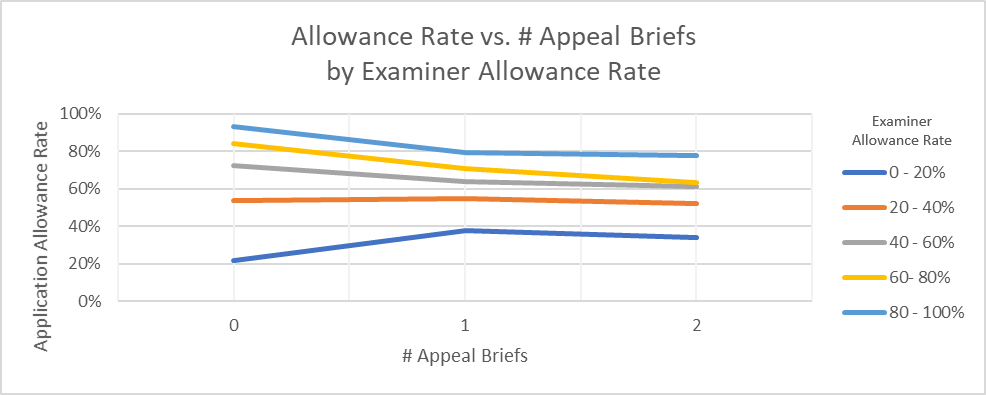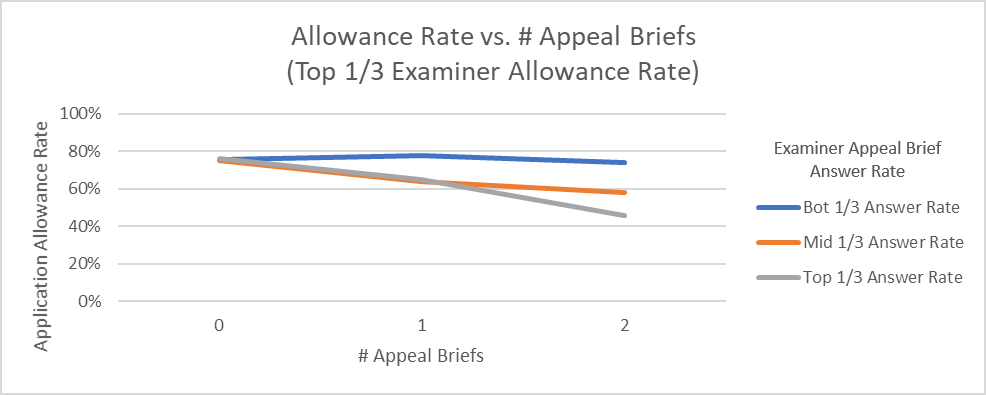In the first post of this series, we saw that, overall, allowance rate goes down with each appeal. That seems to intuitively make sense because, in an ideal world, an appeal is a “close call” that could go either way and thus allowance rates should converge toward 50%. So, since the overall allowance rate is ~75%, then each appeal takes the overall allowance rate closer to 50%. But if your examiner has a sub-50% allowance rate? Let’s take a look.
Lookup your examiner’s appeal stats now, for free, with BigPatentData Examiner Statistics
For Low-Allowance-Rate Examiners, Allowance Rate Goes Up with First Appeal Brief
The first chart below shows the change in allowance rate with increase in number of appeal briefs filed in a particular application. The sample sizes get pretty small pretty quick, so I am mostly just going to focus on the first appeal brief. A you can see, for examiners with higher allowance rates, a first appeal brief is associated with a drop in allowance rate, as we saw in the previous post. But, for those examiners with the lowest allowance rates, filing an appeal brief is associated with a roughly 15% increase in allowance rate. Again, this seems to make perfect sense if we assume applicants, on average, are appealing applications that are at least a coin toss.
For purposes of comparison, here is the same chart for number of RCEs:
As with appeal briefs, a first RCE seems to get the most bang for your buck with examiners that have the lowest allowance rates. Unlike with appeal briefs, however, allowance rate does not go down for high-allowance-rate examiners. Presumably this is because an RCE typically includes amendments that narrow claim scope.
For Examiners that Don’t Answer Many Appeal Briefs, Allowance Rate Goes Up with First Appeal Brief
Another examiner statistic that helps when deciding whether to appeal or file an RCE is the percentage of appeal briefs answered (as opposed to allowing the application or reopening prosecution). The chart below shows that the first appeal brief is actually associated with an increased allowance for examiners who answer fewer than 20% of their appeal briefs.
As you can see from the above chart, there is some correlation between allowance rate and percentage of appeal briefs answered (examiners with higher allowance rates tend to answer fewer appeal briefs), but the correlation is not as strong as I would have suspected — a correlation coefficient of -0.25. For that reason, I decided to look at the allowance rate when grouping examiners by both allowance rate and appeal brief answer rate.
For One Group of Examiners, Allowance Rate Was 27% Higher In Applications With an Appeal Brief
The first chart below looks at the group of examiners that are in the top 1/3 in terms of allowance rate, and splits them into cohorts based on whether they are in the top 1/3, middle 1/3, or bottom 1/3 in terms of percentage of appeal briefs answered. The second chart does the same for examiners in the middle 1/3 in terms of allowance rate. The third chart is for 13 of examiners with the lowest allowance rates.
As you can see, appeal briefs appear to be most effective for examiners that are in the lowest third of both appeal answer rate and allowance rate. For that cohort, the allowance rate is 27% higher with 1 appeal brief than with 0.
So, there you have it. If you examiner is an outlier in terms of having a very low allowance rate AND a very low percentage of answered appeal briefs (like examiner Becker, for example), that may be a good case for going with an appeal brief over an RCE (assuming, of course, your arguments have merit and you are not just being stubborn!). But, if the examiner does answer, the appeal is likely going to take a lot longer, and cost more, than the RCE route (you can of course, still fold your cards and go the RCE route).
Like this post? Please subscribe! Better yet, register for a free trial and check your examiner’s stats.






